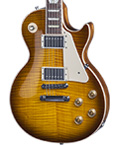
It’s the 2016 A to Z Blog Challenge, so I thought I’d focus on one of my favourite subjects: Guitars. Care to join me?
Les Paul
What can be said about Les Paul that hasn’t already been said? He was an innovator of electric guitar, creating one of the first solid-body electric guitars. He took an ordinary railroad tie, threw a pickup and strings on it, ran a current through the whole set up, and, behold! Electric guitar. I saw an interview with him shortly before his death in which he said the “Log,” as it was called, was not very well received by earlier audiences. Oh, the audiences recognized the playing technique and the chords, and the sound the instrument made were somewhat familiar, but they were put off by the board-like shape. Once Les Paul added curved pieces to make the Log look more like a traditional guitar, audiences were much more accepting.
Les Paul’s playing style was greatly influenced by Django Reinhardt, maintaining a friendship with the gypsy jazz player until Django’s death in 1953. Much of Les Paul’s early career was spent playing jazz. He formed a trio with Chet Atkin’s older half-brother, before being drafted and spending his military career working for the Armed Forces Radio Network as a backup musician, although he did get to perform in his won right. It is probably his partnership with wife, Mary Ford, that was the most prolific, with the duo charting 16 top ten hits between 1950 and 1954.
Les Paul is most closely associated with Gibson, which manufactured the iconic Gibson Les Paul guitar so beloved by rock guitar gods like Slash, Eric Clapton, Jimmy Page, Ace Frehley, and Pete Townsend, among other. In addition to the guitar that bears his name, Les Paul was an early innovator of such recording techniques as overdubbing, in which a new performance is layered on top of an existing performance, phasing, which modulates the pitch frequency, and tape delay. He was also among the first to use multi-track recording in which each instrument is recorded separately and the resulting tracks melded together to create a cohesive song.

The iconic Gibson Les Paul.
Despite severe arthritis that left his right hand all but useless and hearing loss, Les Paul had a standing Monday night gig at the Iridium Jazz Club in New York City that he kept almost up until his death in 2009.
He is one of the few artists to have a permanent, stand-alone exhibit at the Rock and Roll Hall of Fame. His influence reaches across genres and generations. He was definitely one of a kind and the guitar world would not have been the same without him.
Try some of these Les Paul tunes out for size:
How High the Moon (with Mary Ford)

I learned about Les Paul and Mary Ford from my father. He played their records frequently, and when I was very young, explained how innovative they were .. Certainly I love the music, technique, sound – all of it. But I especially love the memories of listening to those LPs with my father on Saturday afternoons. Thank you.
LikeLike
There’s nothing like that human connection, is there? I feel the same way when I listen to Johnny Cash or George Jones. Immediately, I remember time j spent with my Dad and how special those times were.
Thank you, so much, for visiting.
LikeLike
I’ve learned quite a few things today. Didn’t know about Les Paul.
LikeLike
Thank you for stopping by!
LikeLike